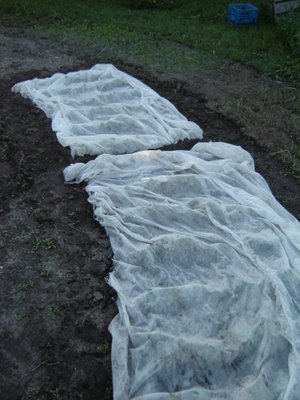
Thursday, December 07, 2006
Friday, September 08, 2006
Frost Warning?
Ouch! How come the text forecast says low of 5 degrees C, but that little icon thingy in my sidebar says 3? That's it. I've got work to do.
Thursday, September 07, 2006
Bedpost #2
Ummm...
Wish I had progress to report...
Gotta go whip up something that looks like progress in the kitchen...
Wish I had progress to report...
Gotta go whip up something that looks like progress in the kitchen...
Wednesday, September 06, 2006
Bedpost #1
The Daily B.E.D.
This foray into daily posting is conceived as a sort of bedtime evaluation of my day, except that I will probably write it the next morning, after everyone else leaves the house. Might be only on weekdays.
B: for Being. Being here. Here in the eternal now. Mindfulness - the "attention" of Timothy Miller's "Compassion, Attention and Gratitude".
E: for Emotions. My emotions. My very own. Somebody quoted somebody the other day, saying (roughly) "The only things that are truly your own are your emotions. Use them well." That might sound frustrating, except for this: in the one week or so that I attended a university psychology class, I learned how to own my emotions. They don't just happen to me. They are not the automatic result of some outside factor. That factor acts on a belief, to trigger the emotion. Change the belief, and you change the emotion. Any emotion arising, then, is a clue pointing the way to the belief behind it, and thus pointing the way to change. (Thanks, Paul.) In the same vein - did you know that Happiness Is a Choice?
D: for Day. This day - and only this day. Day by day, bit by bit - but for now, just this one. This moment of this day.
I was thinking all this yesterday morning, and it felt good, felt hopeful. Got up with good intentions. Found myself at the end of the day with not much to show except a very sarcastic blog post. Much the same sad situation as I'd sat in all last week.
Why?
Well, it could be partly this thing that's going around, but still.
This morning, as I slumped through another utterly pointless computer-simulated card game, I asked myself why I was doing it. And the answer made sense. The game represents a clearly defined and limited problem, with a high probability of successful resolution. (I play FreeCell, and I nearly always win. I do allow myself unlimited restarts.) The reward comes quickly.
Faced with a choice between the messy, no-quick-fix problems of daily life, or the straightforward, get-'em-done problems of a computer game, I've been choosing the latter.
Similarly, I've been blogging a lot, tackling big problems, except not really tackling them, just talking about them. I love to write, and it doesn't even matter if anyone reads it (that's a bonus). Again, the satisfaction is that I get a quick resolution to the problem I set myself: writing a blog post. It's a comfy substitute for doing some concrete work on an infinitesimal bit of the real problem.
It's funny, though. In a teamwork situation, I tend to pick the hardest or most unpleasant tasks for myself. Why pick the easy stuff when I'm alone?
This foray into daily posting is conceived as a sort of bedtime evaluation of my day, except that I will probably write it the next morning, after everyone else leaves the house. Might be only on weekdays.
B: for Being. Being here. Here in the eternal now. Mindfulness - the "attention" of Timothy Miller's "Compassion, Attention and Gratitude".
E: for Emotions. My emotions. My very own. Somebody quoted somebody the other day, saying (roughly) "The only things that are truly your own are your emotions. Use them well." That might sound frustrating, except for this: in the one week or so that I attended a university psychology class, I learned how to own my emotions. They don't just happen to me. They are not the automatic result of some outside factor. That factor acts on a belief, to trigger the emotion. Change the belief, and you change the emotion. Any emotion arising, then, is a clue pointing the way to the belief behind it, and thus pointing the way to change. (Thanks, Paul.) In the same vein - did you know that Happiness Is a Choice?
D: for Day. This day - and only this day. Day by day, bit by bit - but for now, just this one. This moment of this day.
I was thinking all this yesterday morning, and it felt good, felt hopeful. Got up with good intentions. Found myself at the end of the day with not much to show except a very sarcastic blog post. Much the same sad situation as I'd sat in all last week.
Why?
Well, it could be partly this thing that's going around, but still.
This morning, as I slumped through another utterly pointless computer-simulated card game, I asked myself why I was doing it. And the answer made sense. The game represents a clearly defined and limited problem, with a high probability of successful resolution. (I play FreeCell, and I nearly always win. I do allow myself unlimited restarts.) The reward comes quickly.
Faced with a choice between the messy, no-quick-fix problems of daily life, or the straightforward, get-'em-done problems of a computer game, I've been choosing the latter.
Similarly, I've been blogging a lot, tackling big problems, except not really tackling them, just talking about them. I love to write, and it doesn't even matter if anyone reads it (that's a bonus). Again, the satisfaction is that I get a quick resolution to the problem I set myself: writing a blog post. It's a comfy substitute for doing some concrete work on an infinitesimal bit of the real problem.
It's funny, though. In a teamwork situation, I tend to pick the hardest or most unpleasant tasks for myself. Why pick the easy stuff when I'm alone?
Tuesday, August 08, 2006
Not Daily Anymore
I'm trying to get back to doing a "daily bed post" - might get there yet. I could go back through all the beds and make sure I noted varieties, spacing, what worked and what didn't. That could be useful next year.
But next year is the problem. I have already lost interest in this garden. Not that it's a disappointment; it has done better than any garden I've ever tended before. But it's not enough. It's too small, and any expansion would run into droughty saline soil, or shade, or resistance from Garth. It needs more water supply, and that means a new roof, and when I think about the new roof, I want to change the roof to expand the house (and put in a cistern, too), and that means permits and planning and way more time than I can realistically imagine finding in my life.
So instead I dream about climbing an even larger mountain - moving back to the hills, where there are rich moist low areas just waiting to grow food. There's just the small problem of a house. And an agreement from Garth. He worries about disagreements with my family over land use, so he'd rather buy his own land. So, then, we would have free rein to do whatever we wanted with the land - and no money to do it.
But next year is the problem. I have already lost interest in this garden. Not that it's a disappointment; it has done better than any garden I've ever tended before. But it's not enough. It's too small, and any expansion would run into droughty saline soil, or shade, or resistance from Garth. It needs more water supply, and that means a new roof, and when I think about the new roof, I want to change the roof to expand the house (and put in a cistern, too), and that means permits and planning and way more time than I can realistically imagine finding in my life.
So instead I dream about climbing an even larger mountain - moving back to the hills, where there are rich moist low areas just waiting to grow food. There's just the small problem of a house. And an agreement from Garth. He worries about disagreements with my family over land use, so he'd rather buy his own land. So, then, we would have free rein to do whatever we wanted with the land - and no money to do it.
Thursday, August 03, 2006
Lettuce Update

The Cimarron Red Romaine in the foreground is still okay, but better if mixed with other greens. It was planted around June 8th, a little later than the now-bitter leaf lettuce in the background, which is about to be pulled for mulch or compost. I hear that Garth gave away several pails of it.

And here's my current delight: a couple of rows of fresh lettuce, just coming into their own. I planted these on July 3rd, under the mulch, and kept peeking underneath until they appeared, just five days later. Then I parted it gently to let them out, and away they went. The soil was cooler under the mulch, and this part of the garden is shaded for part of the day, which may have helped too. Next year I want to pay more attention to successional planting, but for this year, with so many of us away in the latter part of July, it worked out okay.
Wednesday, August 02, 2006
Now it's a maze

Here's the spaghetti squash again. And the pumpkins, and the "west squash," all blending together. There used to be a path through the middle there. No more walking the labyrinth these days, but it's fun to pick my way through there and come across startlingly large squashes swelling under the leaves. Just a couple of weeks, and I'll start pinching the vines back.
Thursday, July 13, 2006
Spaghetti Squash

Labyrinth Location: 2nd yin-dot arc, 1 to 2 o'clock
Vegetable: Spaghetti squash
Seed/Transplant Date: June 5 or so?
Soil Preparation: Rototilled lawn, with some grass rhizomes pulled out, and hills made with a shovelful of manure underneath
The spaghetti squash are the two hills near the centre of the photo, with pumpkins in the background and the "west squash" crawling across the path from the bed on the right. Tomorrow I leave for the Great Sandhills, and I won't be back for over two weeks. It could be a jungle when I get home. If you see Garth, remind him to train those vines, will ya?
Wednesday, July 12, 2006
The West Squash

Labyrinth Location: 1st yang-dot arc, 2 to 5 o'clock
Vegetable: A winter squash
Seed/Transplant Date: June 5 or so
Soil Preparation: Rototilled lawn, with some grass rhizomes pulled out, and hills made with a shovelful of manure underneath
I mentioned the South Squash a couple of weeks ago; these are the West Squash. One direction is acorn and the other is butternut squash, but I don't know which is which.
I've been training some of the other squash vines along the empty areas between the hills, to keep them out of the labyrinth paths, but these vines don't seem to be vining along the ground. They are reaching for the sky, and quite uncooperative about being twisted into the desired direction. Maybe I just need to wait until they get too heavy for themselves.
Tuesday, July 11, 2006
And How They Grew

Labyrinth Location: 3rd yin-dot arc, 9 and 11 o'clock
Vegetable: Green peppers
Seed/Transplant Date: Same as tomatoes
Soil Preparation: Same as tomatoes
Those are Mary Milligan's above. These I got from my mom:
 They're taller, but a bit lanky looking.
They're taller, but a bit lanky looking.And these are my own.

Wow, that middle one looks fantas... wait a minute, that's a sunflower.
I've been meaning to transplant that volunteer out of there, but I'm starting to think it's too late.
Monday, July 10, 2006
Got 'im
 Bet you never expected to see me proudly displaying a dead varmint on this blog. I'll spare you the pictures, then. (They turned out rather blurry anyway.) Above you see the trap, sprung - there is indeed a dead pocket gopher in there. At the lower left you can see the carrot we placed for bait. It's one of our own carrots, and it probably would have been gopher food by tomorrow if we hadn't resorted to this small violence. The little white archway is a piece of a plastic yogourt tub, which had a previous incarnation as a cutworm collar but got cut in half for this gig. We were trying to simulate the original tunnel opening, and it looks like we were successful.
Bet you never expected to see me proudly displaying a dead varmint on this blog. I'll spare you the pictures, then. (They turned out rather blurry anyway.) Above you see the trap, sprung - there is indeed a dead pocket gopher in there. At the lower left you can see the carrot we placed for bait. It's one of our own carrots, and it probably would have been gopher food by tomorrow if we hadn't resorted to this small violence. The little white archway is a piece of a plastic yogourt tub, which had a previous incarnation as a cutworm collar but got cut in half for this gig. We were trying to simulate the original tunnel opening, and it looks like we were successful.There were several surprises here.
For one thing, I didn't know pocket gophers were so big. I expected something mouse-sized, but the one we caught was more like a Richardson's ground squirrel in girth, though not so long in the body.
Secondly, I was amazed by its digging claws. The picture on the site I linked above doesn't do them justice. If we catch another one, I'll try to get a better picture.
Thirdly, I definitely hadn't expected to find a tunnel open to the surface. When we set out to place my new traps (acquired in Carlyle's amazing Home Hardware store this afternoon), we just assumed we would have to dig to find a tunnel. We started right in next to the mounds, sacrificing a few carrots in a row where several plants had already gone missing (pulled down from below). Not so easy. Apparently the gopher had plugged the tunnel there. Garth went to look for a rod to probe around the mounds, and I gazed around, wondering where to start. I noticed a very small pile of what looked like gopher-pushed dirt, away on the other side of the next bed, close to the edge of the lawn. When I took a closer look, I found an actual opening down into a gopher tunnel. I don't think I'd ever seen one before - not a pocket gopher tunnel. Ground squirrels make their front doors obvious, but pocket gophers will have mounds of pushed-up dirt dotting the landscape and not a single hole in sight.
We think maybe the lawn edging had something to do with it, forcing the pocket gopher to either surface or dig deeper.
And one more surprise: catching a pocket gopher so fast. I think we had it inside of an hour after the trap was set.
We reset the trap (or, to be precise, replaced it with a second trap while the first one gets rinsed and aired out). Here it is being buried.
 It's a Victor "Black Box" gopher trap. They recommend setting two traps end to end, which is why I bought two, but in this instance we figured one would do. And it did.
It's a Victor "Black Box" gopher trap. They recommend setting two traps end to end, which is why I bought two, but in this instance we figured one would do. And it did.I feel like I should make some witty remark, or say something apologetic. Yes, folks. Things die in my garden.
Sunday, July 09, 2006
Mary's and Mine

Labyrinth Location: 2nd border arc and 3rd yin-dot arc, where they meet
Vegetable: Tomatoes
Seed/Transplant Date: I dunno. Sometime after May 21 and before June 5th, I'd say.
Soil Preparation: Existing garden, the usual.
Manitoba tomatoes on the left, Beefsteak on the right. I got the seedlings from Mary Milligan. She said they were her best ever, and they have done beautifully. Transplanting didn't seem to bother them in the slightest, and look at these fruits already!
 (See what I mean about the mud?)
(See what I mean about the mud?)Now for a peek beyond the Manitobas, between them and the shrouded turnips.

These are the Roma tomatoes I started indoors. When I transplanted them (at the same time as Mary's), they were barely starting to grow some true leaves. They seem to have recovered from whatever I did wrong (letting them get chilled, I think), but I will be amazed if they grow more than a handful of fruits.
Saturday, July 08, 2006
Good News and Bad News
Sometimes it's more of a nightly bed...
 Labyrinth Location: Outer border arc, 11 o'clock
Labyrinth Location: Outer border arc, 11 o'clock
Vegetable: Lettuce
Seed/Transplant Date: Monday (July 3rd)
Soil Preparation: Mostly existing garden bed, I think, but near the edge and rather grassy. Has been under mulch for a week or two.
The good news - it worked! I planted this lettuce by peeling back some mulch, seeding the row, and covering it with mulch again. That kept the soil cooler, and the lettuce grew in spite of the hot spell we've had. I pulled the mulch aside a little bit this morning to let the plants out into the sun.
The peas I planted at the same time aren't up, but I'm still hoping.
Now for the bad news.

Those mounds appeared just this afternoon. Pocket gopher, I think. They were common on the farm, but I have never noticed any sign of them in town before.
The disheartening thing is, immediately off the right-hand edge of the picture is my carrot bed.
Battle strategy, anyone?
 Labyrinth Location: Outer border arc, 11 o'clock
Labyrinth Location: Outer border arc, 11 o'clockVegetable: Lettuce
Seed/Transplant Date: Monday (July 3rd)
Soil Preparation: Mostly existing garden bed, I think, but near the edge and rather grassy. Has been under mulch for a week or two.
The good news - it worked! I planted this lettuce by peeling back some mulch, seeding the row, and covering it with mulch again. That kept the soil cooler, and the lettuce grew in spite of the hot spell we've had. I pulled the mulch aside a little bit this morning to let the plants out into the sun.
The peas I planted at the same time aren't up, but I'm still hoping.
Now for the bad news.

Those mounds appeared just this afternoon. Pocket gopher, I think. They were common on the farm, but I have never noticed any sign of them in town before.
The disheartening thing is, immediately off the right-hand edge of the picture is my carrot bed.
Battle strategy, anyone?
Friday, July 07, 2006
What Happened Here?

 Much of the garden has a bit of a lean to it, but it's worst among these broad beans. The lettuce just looks sort of sprawled. Anything that wasn't mulched is mud-spattered, as much as a foot up the stems.
Much of the garden has a bit of a lean to it, but it's worst among these broad beans. The lettuce just looks sort of sprawled. Anything that wasn't mulched is mud-spattered, as much as a foot up the stems.When we left this morning everything was dusty dry. As we came back from the city this afternoon, there were thunderheads off in the distance, and I looked at them longingly. We did some errands around town before actually coming home, and suddenly I noticed the puddles on the streets. Hurrah! We got rain!
As soon as we parked in our driveway, we jumped out and headed for the rain gauge. But Garth stopped at the rain barrel, and I could hear his disappointment as he announced, "Only about an eighth." He was a little off, I think. Actually the rain barrel had come up about what we would expect from two tenths.
But the rain gauge showed nearly four tenths.
And the lawn didn't seem squelchy at all. In places it still seemed dry.
Brian cleared up the mystery. He said all that rain came in one short burst, in wind-driven sheets. Some of it must have flowed over the edge of the eavestrough instead of into the barrel. I suppose a lot of it must have run right off the garden, too. Maybe two tenths is the best estimate after all.
Wednesday, July 05, 2006
Drought Stress

Labyrinth Location: Outer border arc, 9 to 10 o'clock or so
Vegetable: Beets
Seed/Transplant Date: May 22?
Soil Preparation: Not enough. Rather grassy yet.
I never think of watering these. I pay more attention to the small seedlings of later planted things, and the tomatoes. But they wilted yesterday, and even after a good dousing, they don't look quite themselves yet. My record keeping is a little erratic, but I think it's been almost two weeks since we had any significant rain.
Mulching seems to help a lot, and I'm trying to get more done, but my supply of clippings has nearly dried up. The lawn is growing very slowly, in the shade; out in the sun, it isn't growing at all, except where I moved sod this spring. Strange - I haven't given it any special attention, but it seems to be the most lush grass of all.
Tuesday, July 04, 2006
Limited Success

Labyrinth Location: 3rd border arc, 11 o'clock
Vegetable: Basil
Seed/Transplant Date: Around the end of May? (started indoors, mid-late April?)
Soil Preparation: Existing garden, rototilled with well-rotted manure tilled in
That's my biggest basil plant. Here's the other extreme.

I think all my transplants got chilled sometime during their stay in the porch across the street, and went dormant. They are finally starting to recover from that and the transplanting. Here are two of the three surviving oregano plants.

In more than two feet of row, I got two plants less than two inches apart. It was awfully tough transplanting these, when they were just a pair of cotyledons and one pair of true leaves, all together making a circle about the size of a capital "C" in a book.
Basil, oregano, and parsley are all close together near the middle of the garden. I also planted a few of each in a small bed right at the entrance to the garden (outer border arc, 6 o'clock). The basil are doing okay, but the peas are looming.

Yesterday I was freezing spinach, since some of the plants were bolting already (perhaps partly due to crowding?). I wonder if I'll still have any fresh spinach when the basil can spare its first few leaves. Spinach pesto is so-o-o tasty.
Monday, July 03, 2006
And the Basic Beans

Labyrinth Location: Outer border arc, 7:30 (green); 2nd yin-dot arc, 9 o'clock (wax)
Vegetable: Beans
Seed/Transplant Date: May 21 or 22
Soil Preparation: Variable; partly existing garden, and partly sod swapped out for garden soil
These beans were featured in the stepping-stone photo in my introductory post. How things have changed! Here's another photo from way back then (June 14th).

Aside to self: today is the day I planted lettuce and peas under the mulch near the South Squash. Check for germination this weekend.
Aside to anyone listening in: How many days to germination for leaf lettuce?
Sunday, July 02, 2006
I'm Back...

Labyrinth Location: Outer border arc, 7 o'clock
Vegetable: Broad beans
Seed/Transplant Date: May 21(?)
Soil Preparation: Same as the Yin Dot
Just back from a weekend away. After a couple of hours of loafing, I realized that the best light had already faded. I took some pictures anyway.
These are broad beans, or fava beans. They are my experimental crop for the year. I had never tried them, but the Harrowsmith Northern Gardener said they were an excellent choice for northern gardens, deserving more use than they get. You can plant them "as early as the soil can be worked." Although I didn't plant that early, and they seemed to take a long time to sprout, I am delighted to see that they are already flowering, a little bit ahead of my green and wax beans. I think they could mature in time to dry on the vines. I won't have a big yield from this little bed, but hopefully enough to see if we should plant more next year.
Aren't they striking flowers?

I've been admiring these ever since they came up. It's partly just the novelty, but I think they are particularly handsome plants. Here is what they looked like on June 14th.

Thursday, June 29, 2006
The South Squash
Labyrinth Location: Outer border arc, 12 o'clock
Vegetable: A winter squash
Seed/Transplant Date: June 5 or so
Soil Preparation: Rototilled lawn, with some grass rhizomes pulled out, and hills made with a shovelful of manure underneath
Okay, I admit it - I don't know what I planted here. I think it was either butternut or acorn squash. I'm calling them the south squash, until they show some evidence of their identity, but I'm not sure they'll get around to that. Here we are right around the solstice, and the shade above was just after noon. They've been coping with some grass pressure, too.
Grass is edible, eh?
But not very nourishing for a human, and not very good for nearby garden plants, either, I'm thinking. My impression is that some weeds can actually benefit the vegetables by loosening soil and bringing nutrients up from deeper levels, but grass doesn't help that way.
Wednesday, June 28, 2006
Time to Move the Rain Gauge
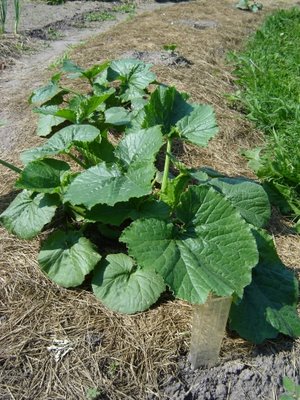
Labyrinth Location: 1st yin-dot arc, 10 o'clock
Vegetable: Zucchini
Seed/Transplant Date: May 22?
Soil Preparation: Existing garden, rototilled with well-rotted manure tilled in; hills made with a shovelful of manure underneath.
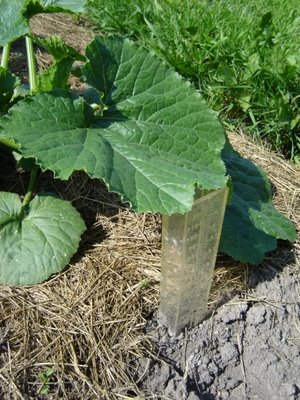
I don't know if it would work as a funnel, or as a roof, but I don't think that leaf would help the accuracy of the rain gauge.
B gave us a couple of big zucchinis already (and they were great in lasagna yesterday), but he got seedlings from a friend. Ours were started in the open. They have flower buds showing, so zucchini season is just around the corner.

They've grown a lot in two weeks.
Tuesday, June 27, 2006
Well, Pumpkins?

Labyrinth Location: 2nd yang-dot arc, 4 to 5 o'clock
Vegetable: Pumpkins
Seed/Transplant Date: June 5 or so?
Soil Preparation: Rototilled lawn, with some of the grass rhizomes pulled out, and hills made with a shovel-full of well-rotted manure under each.
I'm wondering if these pumpkins are well enough along to produce this year. I don't think I've ever grown a winter squash, of any kind, so it's very hard for me to judge. I think most people around here start their winter squashes indoors. That was my plan, too, but by the time it was indoor planting time for squashes, I was so discouraged with my other seedlings, I just didn't bother.
There are two hills of pumpkins in the picture, one directly behind the other, with a little patch of peas in between. We got tired of planting peas in the pea patch, and we had quite a bunch of them soaked and ready, so Garth took the extras and broadcast them on this new section of the garden. At that time, I wasn't sure if I'd be planting anything here, or just keeping it fallow to kill the grass. He raked them in a bit, but I could see a lot of them just sitting on top of the ground. Amazingly, nothing seemed to eat them. I found one that sprouted and grew, right out on the surface of the soil. Now I'm just letting them grow, as long as they don't crowd the squashes.
Here's the same piece of ground, from a slightly different angle, on June 14th. The near hill from the above picture is just right of centre in this one, with the second hill near the top left (in the not-yet-mulched area).
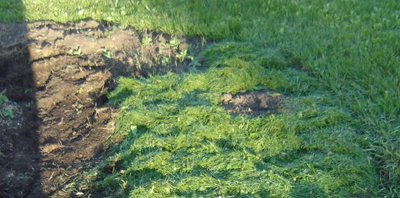
By Request . . .

. . . a closer-up picture of purslane (portulaca). Breathe deeply now - there's no need to send the weed inspector. This is part of our crop.
Here's a closer look at the flower, with an unfortunate blur/flare just where you'd like to see some detail.

Notice the fleshy leaves. The mucilaginous quality of this plant is said to make it a very good addition to soups and stews.
Here's one more close-up, of a plant that hasn't developed into a mat yet. You can see the way it branches out along the surface of the soil.

Monday, June 26, 2006
The Potato Portulaca and Pigweed Patch

Labyrinth Location: Not even close. Across the street.
Vegetable: Potatoes
Seed/Transplant Date: May 20?
Soil Preparation: Rototilled existing garden (borrowed space from bro-in-law).
Picked a pail a' portulaca . . .
. . . and it's quite tasty stuff, kind of lemony flavoured, but most of it is still in the fridge, waiting for me to try cooking Mexican Purslane Stuffing. Purslane is what you call it when you're planning to eat it. When you're getting hypertensive over any little sprig of it in the garden, you call it portulaca.
By the way, I think they left a step out of that recipe. They forgot to actually add the purslane. I'm guessing that happens right before you "saute until . . . the flavours marry."
I was introduced to purslane as a food by my dear friend Anita, just last summer. This year I was watching for it in my garden, and feeling rather sad that I hadn't found a single sprig. My mom is almost obsessive about cleaning out every last leaf, since even one tiny leaf can root and grow again. I guess I must have followed her teaching too well in the last couple of years.
Then I went across the street to check the potatoes. Bonanza! The ground was almost carpeted with it. Like I said, I picked an ice-cream pail full, and that was, oh, less than a third of the patch. And I wasn't picking the patch clean, either - leave some for next year, I figure!
I had bits of it on sandwiches and stuff, but before I could get 'round to cooking up that dish I linked above, I pulled a bunch of redroot pigweed from the yin-yang garden, and found another recipe: Stir-Fried Pigweed with Coconut (pdf). I was halfway through preparing the leaves, when I decided I didn't have enough, so across the street I went again to the patch of plenty. We had a great feed of stir-fried pigweed, and it was delicious - a delightful meal, except for the kids' reaction. After they had stirred up a heated argument and fried everyone's nerves, Ruth tried some and decided she liked it. James, on the other hand, declared that he will be doing all the cooking this summer.
Here is a wider view of the potato patch. There's an enormous volunteer spinach on the left, and the odd dill plant or radish scattered through. The larger darker potatoes in the middle distance are from purchased Pontiac seed potatoes, while the foreground is whatever variety we've been growing and eating for years - Netted Gems, maybe? The background area, behind that row of Pontiac potatoes, is B's garden.

And today I found a single purslane plant in the last untended corner of the yin-yang garden. I wonder. Should I break it up and spread it around a bit, for next year?
Sunday, June 25, 2006
The Yang Side
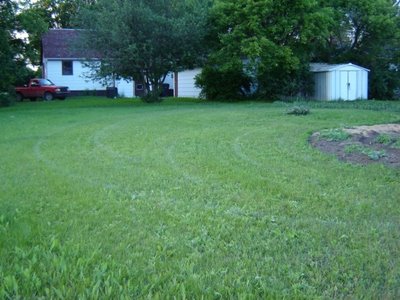
It's not really a bed, but I wanted to show you the yang side of my yin yang garden, now that I finally drew out the arcs of the labyrinth in the lawn. See the faint white lines? They're only marked with flour, so they're temporary. They are also nearly invisible when you look across the labyrinth at a low angle. When you actually walk it, you are seeing the lines close up and from above, so they show up quite well.
I walked it for the first time yesterday, and I found there was a very pleasant sense of arrival at a place of tranquillity when I reached the exit at the south end, looking out over the grassy expanse of the brick ponds. Then I walked back through it in the other direction, and found myself resisting, reluctant to follow this path back to the demands of daily life. Gradually I came to terms with it, though. When I emerged where I began, I felt a slightly uneasy thrill as I noticed that my hands were tingling. I used to get that same sensation after a good long session of Tai Chi.
I've been pausing from my gardening to gaze at it and wonder. If I remember correctly, a wide flat lawn area would actually be considered more "yin" than a gardenscape with its more complex surface including more vertical elements. Maybe the lawn part is actually the yin side. In that case, I believe I have it laid out backwards, since the yin side is supposed to lie mostly towards the south. (If you're thinking the black part of the symbol is mostly towards the top, you're right, but keep in mind that south is placed at the top of a map in Chinese traditions.) *UPDATE: Nope, I got that backwards. Yin, the black area, is mostly to the north. Feng shui expert I'm not. Here's a detailed discussion. I still haven't decided for sure which side of my labyrinth is really yin and which is yang. Maybe there's some wisdom in that.*
Oh well. This layout works better with the contour and soil conditions of my yard.
A school class might be coming to see the labyrinth tomorrow. I'll try not to talk too much about the philosophy. They might like to hear about how I made it. Here you see me marking the lines, using a rope tied to a peg to guide the "limer" (borrowed from the school) along an arc.
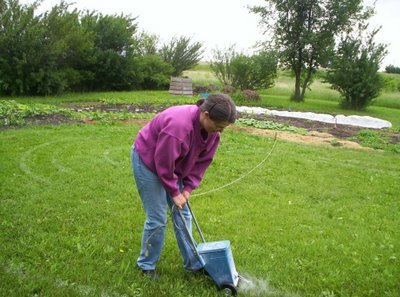
This arc, drawn with the rope staked at the centre of the whole design, is what I refer to as a "border arc," because it is stepped in from the border of the design. Just behind me in the picture, you can see some tighter arcs that were drawn with a rope staked at the centre of the yin dot (which is hidden behind me). I call these the yin-dot arcs. At the right edge of the picture, closer to the garden, I drew some yang-dot arcs. The only tricky part was remembering which arcs had to join up, and where, so that I didn't extend any arcs too far.
Armed with this new information, you might be able to figure out my "Labyrinth Location" codes. Some tricky points: I number the border arcs inward from the outside, but I number the dot arcs outward. Points of the clock refer to one of three different imaginary clock faces. If we are talking about a dot arc, the clock face is centred on the corresponding dot. If we are talking about a border arc, the clock face corresponds to the entire design. And finally, since south is at the top of the yin yang symbol, 12 o'clock means south. Clear as mud? Good.
I know, I need a diagram. Soon. Well, that is to say, maybe this winter.
Saturday, June 24, 2006
Just Spinach

Labyrinth Location: 2nd yin-dot arc, 11 o'clock
Vegetable: Spinach
Seed/Transplant Date: May 23 (?)
Soil Preparation: Existing garden, rototilled with well-rotted manure tilled in
Freshly mulched with grass clippings from the collecting basket on the reel-type mower. I've let the lawn get too long again, so I'll have to switch to the gas mower for the rest of it . . . sigh . . . but I'm always learning. I noticed that it really doesn't take much gas to do the whole yard, and yet it saves a rather large amount of effort. It boggles my mind to think of how much energy I use up with every gallon of gas. It's far more precious stuff than its price would indicate.
Maybe it's time to learn to sharpen the scythe, and swing it just right. When I was a teenager, I could swing it well enough to mow down a waist-high tangle of weeds and poplar suckers, but I'm thinking it would take a little more skill to mow just an inch or two off the lawn. And then I'd have to rake it, too. Maybe it's time to learn some discipline and use the reel-type mower a little more often.
Friday, June 23, 2006
Under Wraps

Labyrinth Location: 2nd border arc, 12 o'clock
Vegetable: Broccoli and Cauliflower
Seed/Transplant Date: When did I set these out? I think it was around June 5th.
Soil Preparation: Variable. Mostly just tilled up lawn. I don't think I even added any manure to this part.
While I was cleaning up under the row cover yesterday, I dug a lot of grass out from around the broccoli and cauliflower. The soil smelled so nice and rich - I don't know if that means it's healthy, or if the decaying lawn residue might be stealing nitrogen at this point. But I did notice that there was a wonderful warm moist microclimate under that row cover.
Mom grew these transplants for me - aren't they lovely? This one is just starting to form some florets.

Thursday, June 22, 2006
Taking a Peek
Labyrinth Location: 2nd border arc, 11 o'clock
Vegetable: Rutabagas (Swede Turnip)
Seed/Transplant Date: May 21 or 22 (?)
Soil Preparation: Existing garden, rototilled with well-rotted manure tilled in.
Have you been wondering what's under the white stuff? All my cabbage-family plants. Mom gave me the floating row covers, and I stitched two lengths together side by side to make a wide enough cover for my three-foot-wide beds.
I was forewarned to leave quite a bit of slack in the cover so the plants don't push it up and lift the buried edges free of the soil. The wind moves the cover around quite a bit, so there are often layers of folded material lying over the plants, but they don't seem to mind. I've been watching the dim green lumps get larger, and itching to get a good look at this vigorous growth...
At first I didn't have enough row cover, so I left about six rows of turnips exposed. Mom found some more cover stashed away, and I headed for the garden, armed with a needle and thread to hand-sew the new piece onto the end of the old.
The flea beetles were there ahead of me.
I put the needle and thread away, and got out the battery-powered vacuum cleaner. Up and down the bed I went, sucking up the tiny blue-black beetles wherever I saw them, back and forth until I didn't see any more. Then I put the new row cover on, but instead of attaching it to the first piece, I buried the edges separately (as you can see above). I didn't want to release any beetles I'd missed into my original covered bed. It meant disturbing the soil rather close to the roots between two rows of turnips, but I had to take one chance or the other.
Well, it looks like I cleaned out the flea beetles pretty well; either that or the plants were almost beyond being vulnerable. They grew vigorously with very little further damage. Today I decided to unearth the row-cover edges from between those two rows, while I could still do it without too much root disturbance. Hand-stitching the edges together was a more gruelling task than I'd anticipated. In hindsight, I might have just dug the whole thing up and taken it in to the sewing machine, but then again, I did see a white butterfly flitting around the edges of the garden as I worked. Bending over, reaching, trying to hold the layers straight and taut by putting my toe on one spot and gripping another, and then trying not to catch extra folds with the needle . . . I didn't have the patience to make a fine seam. I hope the flea beetles or cabbage butterflies (or whatever it is I'm keeping out) aren't too persistent at looking for a gap.
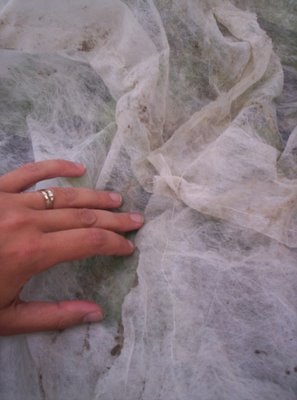
Ah, the suspense. Yes, I did pull the cover loose all the way up one side of the bed to do some weeding and thinning. Wow! I've never grown such a blanket of turnips. In fact, I'm not sure I've ever successfully grown a turnip at all.
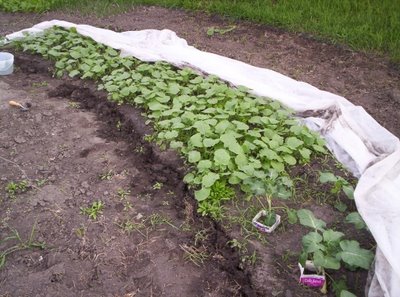
But I didn't dare leave them like that. I've been trying to convince myself to leave things thicker, and thin them gradually just enough to keep them looking happy. Under the row cover, though, I can't really see what's going on, and with the fuss of uncovering and re-covering, I just might procrastinate too much.
So I thinned them.

Now, who is going to eat all those greens?
What does one do with turnip greens? "...country as a turnip green..." - I know the song, but I don't know what it means. Somehow in all the excitement of learning how to garden, I overlooked the importance of learning how to cook.
Subscribe to:
Posts (Atom)



